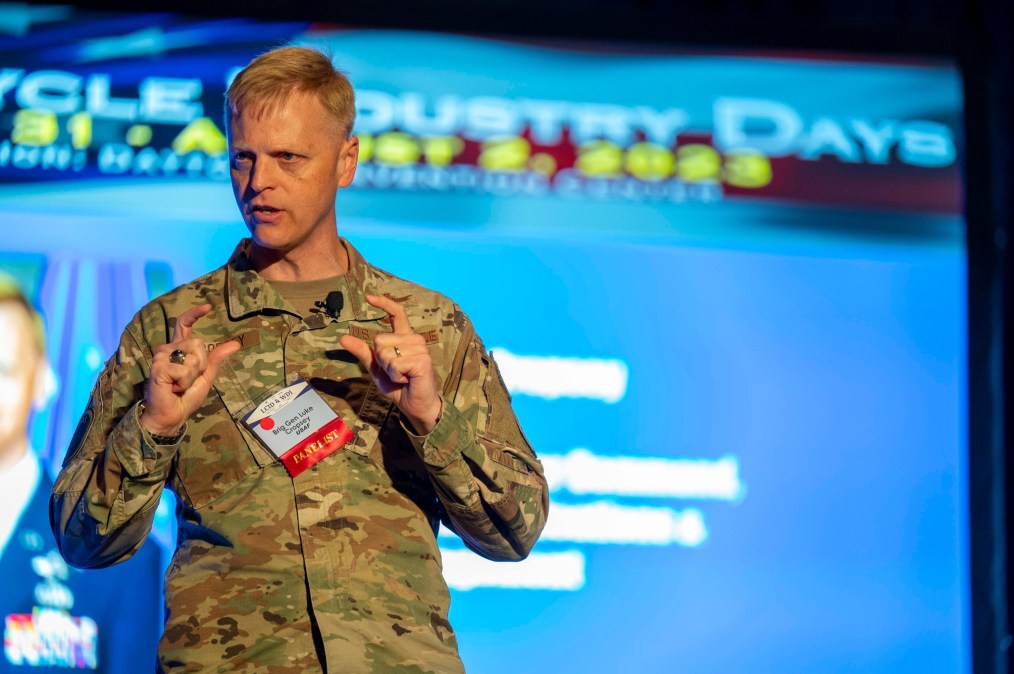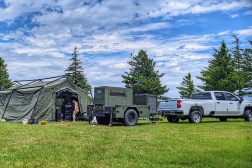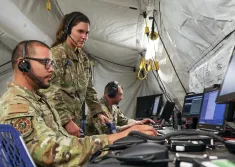Cropsey: Air Force C2 modernization ‘hamstrung’ by lack of fiscal 2024 budget

AURORA, Colo. — Congress’ inability to approve a budget for fiscal 2024 has forced the Air Force to put a number of command-and-control modernization efforts on the back burner, the service official charged with the initiative told reporters Wednesday.
Federal agencies have been operating under a continuing resolution since the beginning of October, meaning spending for the Defense Department and other agencies has largely been frozen at fiscal 2023 levels. The budget instability has caused Brig. Gen. Luke Cropsey, program executive officer for command, control, communications and battle management (C3BM), to pump the brakes on some of his plans for this fiscal year.
“Not having a budget, it’s quite frankly what’s killing me,” he said during a media roundtable at the annual AFA Warfare Symposium. “My budget was supposed to double this year, so my ability to do what we need to do at scale is literally completely hamstrung right now.”
Cropsey is charged with leading modernization for the Department of the Air Force’s C3BM enterprise, which is its contribution to the Pentagon-wide effort known as Joint All-Domain Command and Control (JADC2). The concept seeks to connect all of the U.S. military’s sensors, shooters and data streams under a more unified network to enable improved, real-time decision making.
Rather than tackle C2 modernization using what Cropsey has referred to as “big bang acquisitions,” his office’s strategy is to simultaneously run multiple smaller contracts for enabling capabilities that will operationally demonstrate and prove the concept can be done. The strategy is to start at the very basic foundational level, then slowly roll out new capabilities and scale them up incrementally, he said.
“You’re going to see lots of very targeted, specific kinds of awards that are coming out to do a thing over here, a thing over there, do some integration, present another capability, and then work it back into the operational scene as quickly as we can,” Cropsey told reporters.
The Air Force has experienced some successes with initial C3BM capabilities that have recently deployed, but Cropsey said that operating at fiscal ’23 spending levels has prevented his office from scaling those technologies. Instead, the Air Force has been prioritizing ongoing efforts using funding from the CR, he explained.
For example, the service delivered the cloud-based command and control (CBC2) capability to U.S. Northern Command and the North American Aerospace Defense Command in October, and those have become operational at the Eastern and Canadian air defense sectors.
Cropsey told DefenseScoop at the roundtable that the plan is to expand CBC2 to other air defense sectors throughout the year. But because deploying the initial capability was a top priority, “I will kick everything else to the curb in order to keep CBC2 on schedule and on delivery — which we have done — but it’s been at the expense of being able to expand that software pipeline into other places and other capabilities,” he said.
The Air Force also deployed 16 Tactical Operation Centers-Light (TOC-L) kits to different locations around the world. The kits — which Cropsey called the “basic building block for where we’re going for infrastructure for C2” — are now being integrated into exercises at both the joint and service levels, he said.
TOC-L is a lightweight, scalable battle management system that can integrate and fuse data from hundreds of feeds in order to create an accurate air picture for battle managers, Cropsey explained.
“Really what we’re talking about is computers, software and the particular apps that you need to manage the data and the decisions that are going to the person that’s got to make them,” he said.
The Air Force wants to move into a phase 2 of the capability that will allow Cropsey’s office to scale the kits out to even more locations, but the contract to do so is dependent on funds that would come from a fiscal ’24 budget — meaning it’s possible that effort will get pushed back, he said.
At the same time, Cropsey has been able to award smaller contracts for different micro-services under CR funding. Two contracts were recently given for “track-fusion integration” — one to a Lockheed Martin-Numerica team and a second to SciTec.
That effort is “going to be on basically a six-month sprint,” Cropsey said. “They’re going to be charging the hill with regards to what we need to do on that front with algorithms and data fusion.”
The Air Force is also working on its Distributed Battle Management Node, which will combine the different individual pieces of the C3BM enterprise into a single capability offering. The effort is ready for initial deliveries to air control squadrons in multiple different areas of responsibilities, he told reporters.
“That’s all going on right now [with] the budget that I can still eat through with a continuing resolution. But to get after it for real I gotta get the [fiscal 2024] drop,” Cropsey said.






